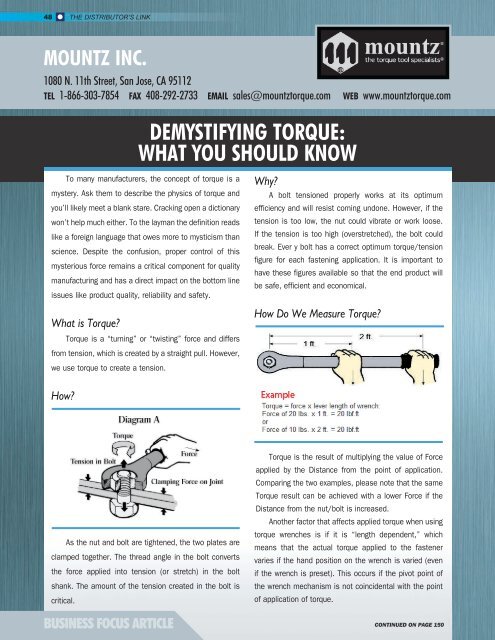FALL 2017
Distributor's Link Magazine Fall Issue 2017 / Vol 40 No4
Distributor's Link Magazine Fall Issue 2017 / Vol 40 No4
You also want an ePaper? Increase the reach of your titles
YUMPU automatically turns print PDFs into web optimized ePapers that Google loves.
48<br />
THE DISTRIBUTOR’S LINK<br />
MOUNTZ INC.<br />
1080 N. 11th Street, San Jose, CA 95112<br />
TEL 1-866-303-7854 FAX 408-292-2733 EMAIL sales@mountztorque.com WEB www.mountztorque.com<br />
DEMYSTIFYING TORQUE:<br />
WHAT YOU SHOULD KNOW<br />
To many manufacturers, the concept of torque is a<br />
mystery. Ask them to describe the physics of torque and<br />
you’ll likely meet a blank stare. Cracking open a dictionary<br />
won’t help much either. To the layman the definition reads<br />
like a foreign language that owes more to mysticism than<br />
science. Despite the confusion, proper control of this<br />
mysterious force remains a critical component for quality<br />
manufacturing and has a direct impact on the bottom line<br />
issues like product quality, reliability and safety.<br />
What is Torque?<br />
Torque is a “turning” or “twisting” force and differs<br />
from tension, which is created by a straight pull. However,<br />
we use torque to create a tension.<br />
Why?<br />
A bolt tensioned properly works at its optimum<br />
efficiency and will resist coming undone. However, if the<br />
tension is too low, the nut could vibrate or work loose.<br />
If the tension is too high (overstretched), the bolt could<br />
break. Ever y bolt has a correct optimum torque/tension<br />
figure for each fastening application. It is important to<br />
have these figures available so that the end product will<br />
be safe, efficient and economical.<br />
How Do We Measure Torque?<br />
How?<br />
As the nut and bolt are tightened, the two plates are<br />
clamped together. The thread angle in the bolt converts<br />
the force applied into tension (or stretch) in the bolt<br />
shank. The amount of the tension created in the bolt is<br />
critical.<br />
BUSINESS FOCUS ARTICLE<br />
Torque is the result of multiplying the value of Force<br />
applied by the Distance from the point of application.<br />
Comparing the two examples, please note that the same<br />
Torque result can be achieved with a lower Force if the<br />
Distance from the nut/bolt is increased.<br />
Another factor that affects applied torque when using<br />
torque wrenches is if it is “length dependent,” which<br />
means that the actual torque applied to the fastener<br />
varies if the hand position on the wrench is varied (even<br />
if the wrench is preset). This occurs if the pivot point of<br />
the wrench mechanism is not coincidental with the point<br />
of application of torque.<br />
CONTINUED ON PAGE 150

















